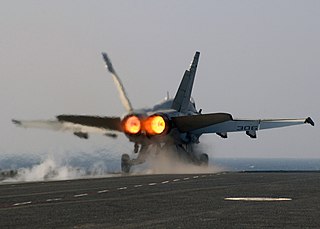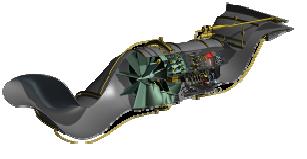
A jet engine is a type of reaction engine discharging a fast-moving jet that generates thrust by jet propulsion. While this broad definition can include rocket, water jet, and hybrid propulsion, the term jet engine typically refers to an internal combustion airbreathing jet engine such as a turbojet, turbofan, ramjet, or pulse jet. In general, jet engines are internal combustion engines.

Pratt & Whitney is an American aerospace manufacturer with global service operations. It is a subsidiary of Raytheon Technologies. Pratt & Whitney's aircraft engines are widely used in both civil aviation and military aviation. Its headquarters are in East Hartford, Connecticut. As one of the "big three" aero-engine manufacturers, it competes with General Electric and Rolls-Royce, although it has also formed joint ventures with both of these companies. In addition to aircraft engines, Pratt & Whitney manufactures gas turbines for industrial and power generation, and marine turbines. In 2017, the company reported that in 2014 they had 38,737 employees supporting more than 11,000 customers in 180 countries around the world. In 2013, Pratt & Whitney's revenue totaled $14.5 billion.

The turbofan or fanjet is a type of airbreathing jet engine that is widely used in aircraft propulsion. The word "turbofan" is a portmanteau of "turbine" and "fan": the turbo portion refers to a gas turbine engine which achieves mechanical energy from combustion, and the fan, a ducted fan that uses the mechanical energy from the gas turbine to force air rearwards. Thus, whereas all the air taken in by a turbojet passes through the combustion chamber and turbines, in a turbofan some of that air bypasses these components. A turbofan thus can be thought of as a turbojet being used to drive a ducted fan, with both of these contributing to the thrust.

A vertical and/or short take-off and landing (V/STOL) aircraft is an airplane able to take-off or land vertically or on short runways. Vertical takeoff and landing (VTOL) aircraft are a subset of V/STOL craft that do not require runways at all. Generally, a V/STOL aircraft needs to be able to hover. Helicopters are not considered under the V/STOL classification as the classification is only used for aeroplanes, aircraft that achieve lift (force) in forward flight by planing the air, thereby achieving speed and fuel efficiency that is typically greater than the capability of helicopters.

The CFM International CFM56 series is a French-American family of high-bypass turbofan aircraft engines made by CFM International (CFMI), with a thrust range of 18,500 to 34,000 lbf. CFMI is a 50–50 joint-owned company of Safran Aircraft Engines of France, and GE Aviation (GE) of the United States. Both companies are responsible for producing components and each has its own final assembly line. GE produces the high-pressure compressor, combustor, and high-pressure turbine, Safran manufactures the fan, gearbox, exhaust and the low-pressure turbine, and some components are made by Avio of Italy and Honeywell from the US. The engines are assembled by GE in Evendale, Ohio, and by Safran in Villaroche, France. The completed engines are marketed by CFMI. Despite initial export restrictions, it is the most used turbofan aircraft engine in the world, in four major variants.

An afterburner is an additional combustion component used on some jet engines, mostly those on military supersonic aircraft. Its purpose is to increase thrust, usually for supersonic flight, takeoff, and combat. The afterburning process injects additional fuel into a combustor in the jet pipe behind the turbine, "reheating" the exhaust gas. Afterburning significantly increases thrust as an alternative to using a bigger engine with its attendant weight penalty, but at the cost of increased fuel consumption which limits its use to short periods. This aircraft application of reheat contrasts with the meaning and implementation of reheat applicable to gas turbines driving electrical generators and which reduces fuel consumption.

The bypass ratio (BPR) of a turbofan engine is the ratio between the mass flow rate of the bypass stream to the mass flow rate entering the core. A 10:1 bypass ratio, for example, means that 10 kg of air passes through the bypass duct for every 1 kg of air passing through the core.

The Lockheed Martin X-35 is a concept demonstrator aircraft (CDA) developed by Lockheed Martin for the Joint Strike Fighter program. The X-35 was declared the winner over the competing Boeing X-32 and a developed, armed version went on to enter production in the early 21st century as the F-35 Lightning II.

The Advanced Tactical Fighter (ATF) was a demonstration and validation program undertaken by the United States Air Force to develop a next-generation air superiority fighter to counter emerging worldwide threats, including Soviet Sukhoi Su-27 and Mikoyan MiG-29 fighters under development in the 1980s. Lockheed and Northrop were selected in 1986 to develop the YF-22 and the YF-23 technology demonstrator aircraft. These aircraft were evaluated in 1991 and the Lockheed YF-22 was selected and later developed into the F-22 Raptor.

The Boeing X-32 is a concept demonstrator aircraft that was designed for the Joint Strike Fighter competition. It lost to the Lockheed Martin X-35 demonstrator, which was further developed into the Lockheed Martin F-35 Lightning II.

The Pratt & Whitney F119, company designation PW5000, is an afterburning turbofan engine developed by Pratt & Whitney for the Lockheed Martin F-22 Raptor advanced tactical fighter.

The Pratt & Whitney F135 is an afterburning turbofan developed for the Lockheed Martin F-35 Lightning II, a single-engine strike fighter. It has two variants; a Conventional Take-Off and Landing (CTOL) variant used in the F-35A and F-35C, and a two-cycle Short Take-Off Vertical Landing (STOVL) variant used in the F-35B that includes a forward lift fan. The first production engines were delivered in 2009.

The General Electric TF39 was a high-bypass turbofan engine that was developed to power the Lockheed C-5 Galaxy. The TF39 was the first high-power, high-bypass jet engine developed. The TF39 was further developed into the CF6 series of engines, and formed the basis of the LM2500 marine and industrial gas turbine. On September 7, 2017, the last active C-5A powered with TF39 engines made its final flight to Davis-Monthan Air Force Base for retirement. The TF39 was effectively retired, and all remaining active C-5 Galaxys are now powered by F138 engines.

The Pratt & Whitney F100 is an afterburning turbofan engine manufactured by Pratt & Whitney that powers the F-15 Eagle and F-16 Fighting Falcon.

The General Electric YF120, internally designated as GE37, was a variable cycle afterburning turbofan engine designed by General Electric Aircraft Engines in the late 1980s/early 1990s for the United States Air Force's Advanced Tactical Fighter (ATF) program. Prototype engines were installed in the two competing technology demonstrator aircraft, the Lockheed YF-22 and Northrop YF-23.

A variable cycle engine (VCE), also referred to as adaptive cycle engine (ACE), is an aircraft jet engine that is designed to operate efficiently under mixed flight conditions, such as subsonic, transonic and supersonic.

The Rolls-Royce LiftSystem, together with the F135 engine, is an aircraft propulsion system designed for use in the STOVL variant of the F-35 Lightning II. The complete system, known as the Integrated Lift Fan Propulsion System (ILFPS), was awarded the Collier Trophy in 2001.

The Pratt & Whitney/Allison 578-DX was an experimental aircraft engine, a hybrid between a turbofan and a turboprop known as a propfan. The engine was designed in the 1980s to power proposed propfan aircraft such as the Boeing 7J7 and the MD-91 and MD-92 derivatives of the McDonnell Douglas MD-80. As of 2019, it is still one of only four different contra-rotating propfan engines to have flown in service or in flight testing.

The ADaptive Versatile ENgine Technology program is an aircraft engine development program run by the United States Air Force with the goal of developing an efficient adaptive cycle, or variable cycle engine for next generation military aircraft in the 20,000 lbf (89 kN) thrust class. The program was succeeded by the Adaptive Engine Technology Demonstrator (AETD) program in 2012 and the Adaptive Engine Transition Program (AETP) in 2016, with the latter focused on developing and testing a 45,000 lbf (200 kN) thrust class adaptive cycle engine for next generation fighter aircraft and potential F-35 re-engining.

The General Electric XA100 is an American adaptive cycle engine demonstrator being developed by General Electric (GE) for the Lockheed Martin F-35 Lightning II and form the basis for the propulsion system for the United States Air Force's sixth generation fighter program, the Next Generation Air Dominance (NGAD).


















